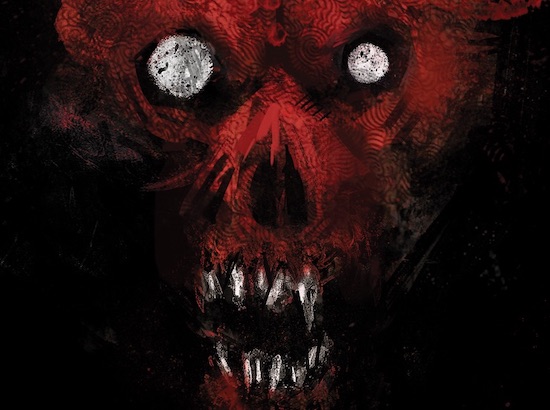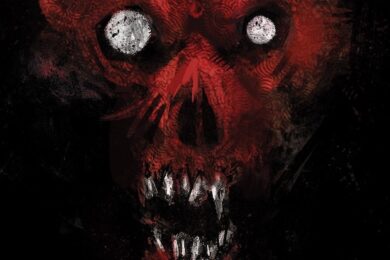The arrival of a new Adam Nevill novel, especially one timed to appear on Halloween, is always an exciting prospect. Ever since bingeing on Nevill’s books in 2014, and interviewing him for tQ in November of that year, I’ve been increasingly convinced that his work ranks alongside the best horror fiction to have ever come out of the UK. Amongst British horror novelists currently working, there’s only really Ramsey Campbell who I consider to be producing genre books of such a high literary quality. At 73, Campbell is a hugely prolific writer, over two decades older than Nevill, but still operating at peak intensity, as evidenced by his excellent 2018 trilogy, The Three Births Of Daoloth. Whilst Nevill’s previous novel, 2017’s Under A Watchful Eye felt a little conflicted to this reviewer, with its articulations of the novelist protagonists’ frustration with his publisher and its ingenious but ultimately sleight of hand based metafictive device, The Reddening is a return to what Nevill does best.
The unearthing of an important prehistoric archaeological find in Brickburgh’s caves brings uneasy revelations regarding mankind’s violent and cannibalistic past. Disillusioned lone parent, Helene, searches for news of her lost brother, last heard of whilst recording disturbing subterranean noises in the area. Lifestyle journalist Katrine escapes London for a coast renowned for natural beauty, but instead becomes embroiled in an investigation into the present day consequences that resonate through history from the discovery. The uncannily Comus-like dark folk band, Witchfinder Apprentice, led by the ageing musician Tony Willows, represent a possible connection to that ancient past. This is slow-burn folk horror, masterfully done, that ratchets up the tension exponentially over 400 pages, before a final reveal that examines the human desire for reprisal and acknowledges that we haven’t, as a species, come as far from our barbaric origins as people might like to think. In drawing a connecting line between the darkness we inhabited in our ancient past, and the tense times we currently occupy, The Reddening strikes a resonating note that reverberates from the dawn of our prehistory and continues to echo threateningly in our present era.
“All about her, the people were loudly and assertively happy, though Helene sensed a taut wire of defiance in the gathering too. An angry, tipsy energy bustled in places, particularly near the pub. She didn’t know where the ire was directed but suspected she’d walked into a community forcing a confirmation of its identity: an idea of itself based on what it knew of the past, or had even lived through but only selectively remembered.”
In a field where much of the best writing takes place in the short-story format, Nevill is one of the best long-form authors the genre has. Whilst there may be other 2019 horror books I’ve not yet read (such as Catriona Ward’s Little Eve, which scooped the Best Horror Novel category at the 2019 British Fantasy Awards, or Chuck Wendig’s intriguingly premised 800-page doorstop of a book, The Wanderers), The Reddening sets the bar for literary horror especially high, even by Nevill’s own standards. I spoke to Nevill, via email, about the first novel to be released on his own imprint, Ritual Limited.
Can you say something about your decision to move from Pan Macmillan to your own imprint.
It’s a huge question, but there were so many variables I had to take into account. It was a huge risk after being trad published for two decades as well as having a couple of offers from editors I really admire on the table. My reasons to go indie on this book were ultimately an equal split between aesthetic and commercial reasons and frustrations. I’ve not been feeling the love for horror from trad publishing for a few years now. Editorial direction is mostly all about the grip-lit thriller, crime, mystery, suspense, epic fantasy, etc, but I write supernatural horror and it takes me a long time to research, write and rewrite a book. I cannot – nor will I – write what publishers can sell best. For a start, their editorial directions will keep changing and genres of fiction will come in and out of vogue. I cannot fit into that if I write in one field. And I’m not keen on getting stranded in no-man’s-land on the barbed wire of the midlist.
At the risk of courting pretension, I have a vision for horror that extends many years into my future as a writer. Horror is what I feel compelled to write. I can only endure the despair and euphoria that writing a novel entails if I feel compelled by the stories that I am writing. This is a folk-horror novel, with thriller elements on structure for sure, but first and foremost it is a horror novel and I wanted the book to come above ground as one. The cover I commissioned, and my choice of artist, Samuel Araya, was a statement of intent aesthetically. This book isn’t going to be mistaken for a procedural crime story.
Commercial publishing is a business; I get that, I worked in the industry for eleven years. But neither the big London publishers nor the book trade, to my eye, seem disposed to horror right now. Mercifully, there are now alternative options. And through the publication of my two collections, via my own imprint that I set up for short stories, novellas and free books, I realised how large the "niche" readership of horror is when viewed internationally. There are huge advantages to making a book available worldwide in four formats on the same day, if I direct marketing at that readership: the only readership that will have any meaningful interest in what I am writing anyway. So, I’m not constrained by the business model of trad publishing if I go indie.
My ideal readership is not the same audience of trad publishers or the book trade – a UK general readership. My readership is an international horror readership and that horror nation is substantial when viewed globally. A UK publisher will publish me in the UK with a catch-all cover, and hope to sell foreign rights in various territories, so my inbox fills daily with readers in the US asking when the new book will be available in America? If a US publisher doesn’t publish a US edition of one of my books, my books will only eventually appear (where most of my readers are) in a trickle on export. I only have four out of nine novels in US editions. But through my own imprint, there is one international edition available worldwide, same day, in a choice of formats. So, by going indie, my potential readership isn’t choked at birth, and I am reaching far more readers than I can through trad published books in the UK. It just makes sense to go indie right now, if I want this book to be read widely.
But indie publishing – and doing it properly – is so time-consuming. I take out six months of a year, at least, publishing just one book in four formats. It’s equal parts frustration and elation. I do enjoy being entrepreneurial though (I also think midlist writers need to be publishers and writers if they are going to survive), but my capacity to keep publishing books the way I want to, as well as writing new books and working on films, is a concern. I assess my capacity and stress-levels every few months. I’m blessed with a clever wife who takes care of business administration, website, newsletters, limited edition fulfilment, text design proofing. I wouldn’t have been able to do this without her help. And I quite like it being a family business too – I have an office on the side of the house that is part of a little industry branching into several fields. I told my eight year old that she will one day inherit Ritual Limited, and as our house has resembled an Amazon warehouse for the last three months, I couldn’t quite read her expression when I made the announcement.
How did Witchfinder Apprentice become a part of the story?
My early experience of folk music was entwined with my early relationship with horror stories. I was haunted as a child by the Steeleye Span music that my Dad used to play – Maddie Pryor’s incredible voice and the stories within their folk songs, particularly ‘Long Lankin’; it all rang bells deeply inside my young imagination. At the same time I was being read ghost stories, chiefly by M R James. Folk music and horror were mixed and in the mix for me from an early age.
I’m drawn to creative outsiders in my stories too – an expressionist painter in Apartment 16, guerrilla documentary filmmakers in Last Days,, a puppeteer and taxidermist in House of Small Shadows, a ghost story writer and an astral projection guru in Under a Watchful Eye, an occult philosopher in Banquet for the Damned. So it was high time for a folk rock musician: Tony Willows and his Witchfinder Apprentice! I created albums and a musical vision that I wanted to exist; a Sabbath/evil Tull of British 70s folk music.
The landscape of your ‘new’ home clearly inspired the novel. How did the idea of ‘ancient discoveries’ ties in with this?
I’ve been walking South Devon’s stretch of the South West Coast Path for five years, swimming in some obscure places and also kayaking the coast and estuaries and cave systems for two years now. How could I not write about it? The ideas for this novel, the very locations, the epochal geology, the atmosphere, the incredible sense of time and of the earth’s long history that surrounds me daily, pretty much informed the novel in its entirety. I composed the notes for this book mentally, mostly while out walking and taking pictures.
Much of my wandering and exploring involved a kind of gaping and lots of notions that remained formless for a couple of years, but the penny dropped in the darkness of Kent’s Caverns in Torquay. I was on a guided tour of the cave system where the earliest remains of homo sapiens were found in Northern Europe, mingled amidst the remains of extinct animals – giant cave bears, scimitar cats, hyenas the size of lions. They all used the caves at the same time. The earliest modern human remains form part of an incomplete jawbone with a tooth attached; it was torn from a face by a giant hyena. When the guide killed the lights and when I heard a recording of a hyena scream underground, I had my entry point into a story. All of the fragments, ideas, observations, notions and experiences outdoors began to coalesce into a whole I could work with. And with a cosmic horror dimension too, so I finally found a place where British folk horror and cosmic horror could meld in a particular remote region.
Can you give us any hints about any future projects?
I intend to publish a third collection next year, in the Spring, and the style and direction will be very different to what folks may expect from a horror collection. Increasingly, I am also working across various film projects. I’ve quite a few things in development, including two original screenplays that I have been working on for the last two years. I hope something will get the trigger. But we’ll see. It won’t be for lack of trying!
The Reddening by Adam Nevill is published by Ritual Limited



